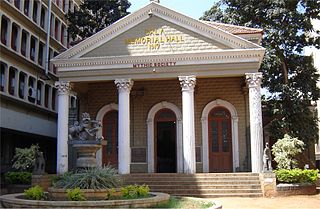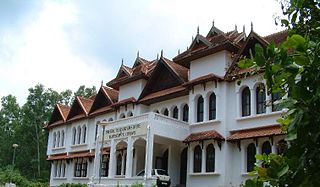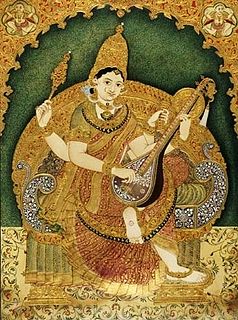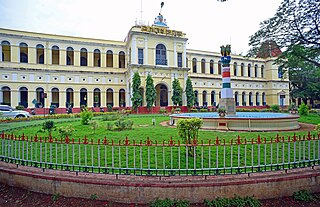
The Kingdom of Mysore was a realm in southern India, traditionally believed to have been founded in 1399 in the vicinity of the modern city of Mysore. From 1799 until 1950, it was a princely state, until 1947 in a subsidiary alliance with British India. It then became Mysore State with its ruler remaining as Rajapramukh until 1956, when he became the first Governor of the reformed state.

The University of Mysore is a public state university in Mysore, Karnataka, India. The university was founded during the reign of Krishnaraja Wodeyar IV, the Maharaja of Mysore. It opened on 27 July 1916. Its first chancellor was the Maharaja of Mysore; the first Vice-Chancellor was H. V. Nanjundaiah. The university became the first outside the British administration in India, the sixth in India as a whole, and the first in Karnataka. It is a state university of the affiliating type, and became autonomous on 3 March 1956, when it gained recognition from the University Grants Commission.

Maharaja Krishnaraja Wadiyar IV (Nalwadi Krishnaraja Wadiyar; 4 June 1884 – 3 August 1940) was the twenty-fourth maharaja of the Kingdom of Mysore, from 1894 until his death in 1940. He is popularly called "Rajarshi"(Kannada Trans. ರಾಜರ್ಷಿ),the name which was given by Mahatma Gandhi, which literally means "the sage king" for his administrative reforms and achievements

Jayachamarajendra Wadiyar was the maharaja of the Kingdom of Mysore from 1940 to 1950, who later served as the governor of Mysore and Madras states.

Tigalari is a Southern Brahmic script which was used to write Tulu, Kannada, and Sanskrit languages. It was primarily used for writing Vedic texts in Sanskrit. It evolved from the Grantha script. It is called as Tigalari lipi in Kannada-speaking regions and Tulu speakers call it as Tulu lipi. It bears high similarity and relationship to its sister script Malayalam, which also evolved from the Grantha script.

The Daly Memorial Hall, is a heritage building located in Bangalore, Karnataka that houses the Mythic Society. The Mythic society, founded in 1909, is a pioneering institution of Indic studies in South India. Daly Memorial Hall, built at a cost of INR 24,783, was inaugurated on 25 July 1917 by the Kanteerava Narasimharaja Wadiyar (the Yuvaraja of Mysore. The Hall is named after Sir Hugh Daly, who served as the Resident of Mysore State and Chief Commissioner of Coorg.

Melukote in Pandavapura taluk of Mandya district, Karnataka, in southern India, is one of the sacred places in Karnataka. The place is also known as Thirunarayanapuram. It is built on rocky hills, known as Yadugiri, Yaadavagiri and Yadushailadeepa, overlooking the Cauvery valley. Melukote is about 51 km from Mysore and 133 km (83 mi) from Bangalore.

The Oriental Research Institute & Manuscripts Library, University of Kerala, is one of the leading centres of Indology in India. It is located at Kariavattom, Thiruvananthapuram, Kerala. The institute carry out researches on Indian language manuscripts, about 80% of which are in Sanskrit. The department is microfilming the manuscripts of certain technical subjects.

The Sritattvanidhi is a treatise written in the 19th century in Karnataka on the iconography and iconometry of divine figures in South India. One of its sections includes instructions for, and illustrations of, 122 hatha yoga postures.
Chamarajendra Academy of Visual Arts (CAVA) is a visual art school in Mysore, in the state of Karnataka in India. The academy is affiliated to the University of Mysore and offers courses in drawing, painting, sculpture, graphics, applied arts, photography and photo-journalism and art history. CAVA awards degrees in Bachelor of Fine Arts (BFA) and Master of Fine Arts (MFA).

Mysore painting is an important form of classical South Indian painting that originated in and around the town of Mysore in Karnataka encouraged and nurtured by the Mysore rulers. Painting in Karnataka has a long and illustrious history, tracing its origins back to the Ajanta times The distinct school of Mysore painting evolved from the paintings of Vijayanagar times during the reign of the Vijayanagar Kings The rulers of Vijayanagar and their feudatories encouraged literature, art, architecture, religious and philosophical discussions. With the fall of the Vijayanagar empire after the Battle of Talikota the artists who were till then under royal patronage migrated to various other places like Mysore, Tanjore, Surpur, etc. Absorbing the local artistic traditions and customs, the erstwhile Vijayanagar School of Painting gradually evolved into the many styles of painting in South India, including the Mysore and Tanjore schools of painting.

Mysore is a city in the state of Karnataka, India. It is known as the cultural capital of Karnataka. Mysore was the capital of the Wodeyar kings who ruled over the Mysore Kingdom for many centuries. Wodeyars were great patrons of art and music and have contributed significantly to make Mysore a cultural centre. Mysore is well known for its palaces, museums and art galleries and the festivities that take place here during the period of Dasara attract a worldwide audience. Mysore has also lent its name to popular dishes like Mysore Masala Dosa and Mysore Pak. Mysore is also the origin of the popular silk sari known as Mysore silk sari and has also given rise to a popular form of painting known as Mysore painting.

The Kingdom of Mysore (1399–1950) was founded by Yaduraya in 1399 as a feudatory of the Vijayanagara Empire and became an independent kingdom in the early 17th century, after the decline of the Vijayanagara Empire. Many musicians and composers have presumably adorned the courts of the Mysore kings from Yaduraya's time, furthering the Dakshinadi school of music that had developed in earlier centuries. However, records are only available from the time of King Ranadheera Kanteerava Narasaraja Wodeyar (1638). Musical treatises surviving from this time, though, provide ample information on the music, musical instruments, the types of compositions, the raga (melodies) and the tala (rhythms) used. Though all the Mysore kings patronised music, the golden age of Carnatic music was considered to be during the reigns of Kings Krishnaraja Wodeyar III (1794–1868), Chamaraja Wodeyar IX (1862–1894), Krishnaraja Wodeyar IV (1884–1940) and Jaya Chamaraja Wodeyar (1919–1974). The reign of Krishnaraja Wodeyar IV is regarded as particularly important in musical terms.

Palm-leaf manuscripts are manuscripts made out of dried palm leaves. Palm leaves were used as writing materials in Indian subcontinent and in Southeast Asia reportedly dating back to the 5th century BCE. Their use began in South Asia and spread to other regions, as texts on dried and smoke-treated palm leaves of Palmyra palm or the talipot palm. Their use continued till the 19th century, when printing presses replaced hand-written manuscripts.

Maharaja's College, Mysore (1889) is a college affiliated to Mysore University.
Rudrapatna Shamasastry FRAS (1868–1944) was a Sanskrit scholar and librarian at the Oriental Research Institute Mysore. He re-discovered and published the Arthashastra, an ancient Indian treatise on statecraft, economic policy, and military strategy.

Manasagangotri is a suburb of Mysore city in Mysore district of Karnataka state, India. Mysore University and its various departments are located in this area.

Chamarajapura is one of the earliest settlements and localities in Mysore, Karnataka State, India, located in the centre of Mysore city. Initially an agraharam, parts of it were later allotted other local dwellers as well.

Doddabele Lakshmi Narasimhachar was a Kannada linguist, grammarian, lexicographer, writer, literary critic and editor who taught at the Department of Kannada Language Studies, University of Mysore between 1932 - 1962. His knowledge of Halegannada helped him in reading ancient epigraphic records. He authored four books in Kannada, edited about nine volumes, penned eleven prefaces, wrote nearly hundred articles across three decades, seven monographs in English and outlined introductions to four Kannada works. He presided over the forty first Kannada Sahitya Sammelan held at Bidar in 1960. He was the recipient of the Kannada Rajyotsava Award from the Mysore State. In 1969, his alma mater - University of Mysore bestowed on him an Honorary Doctorate in recognition of a lifetime contribution to the world of Kannada studies.



















